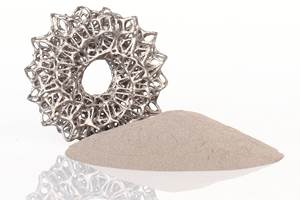U.S. Military Officers Cautiously Optimistic On AM for Repair Parts
The challenges of worldwide 3D printing by the military include confidence in AM processes and cybersecurity. The rewards of overcoming these will include improved affordability, improved repair capability and greater military readiness.
Article originally appeared in Aviation Week. Used with permission.
Imagine a decade from now, maintainers aboard a U.S. aircraft carrier at sea using additive manufacturing to “print” a moderate repair part for an F-18, allowing the fighter to get back in the air quicker while optimizing military readiness, capability and costs.
Whether that vision becomes reality in just 10 years or longer remains to be seen, current and former military leaders said at the Aviation Week MRO Americas conference held in Dallas on April 5. But this scenario, or others like it, is coming. Unfortunately, it just might feel like a lifetime until it transpires, they suggested.
“If you have an idea of what you think additive manufacturing is going to look like in 10 years, I would tell you your ideas aren’t big enough, your dreams aren’t ripe enough,” said Jim Regenor, director of advanced manufacturing services at Moog Inc. and a retired U.S. Air Force colonel with command and Joint Staff experience.
Just do not expect it anytime soon. “Sometimes the Air Force and the Department of Defense can’t get out of [their] own way when it comes to inserting new technologies—I know that,” said Lt. Gen. Lee K. Levy II, commander of the Air Force Sustainment Center. “We’re very conservative.”
Yet, cautious optimism dominated the military portion of the annual MRO (maintenance, repair and operations) conference, as leaders like Regenor and Levy discussed additive manufacturing, as well as other groundbreaking technologies like digitization, “big data,” analytics, virtual reality and others. Panelists at the conference predicted such technological innovations will be implemented on the commercial side of the MRO industry first, and mainly to help reduce costs and grow profit margins. But they will eventually and naturally be incorporated on the military side, where government customers now care about affordability almost as much as military readiness and capability.
“Keep bringing those ideas, keep banging on the door,” Levy pleaded in his keynote address. There are challenges to adopting such technology in the military, but they can only be overcome by working through them, he said.
For instance, with additive manufacturing, the industry will have to gain more confidence about the material science behind printed materials, including faults and tolerances. Beyond airworthiness standards, military specifications will demand a new category of molecular understanding and documentation. “It has great benefits, great potential, great risks,” Levy said. “It doesn’t have the same maturity or levels of experience, engineering pedigree, in some cases.”
There are also deep concerns about cybersecurity, he and others said, as the promise of worldwide printing entails communication of massive data packs. Also, the end-goal cannot just be printing something once, but in reliable replication countless times. Finally, there will be a slew of training and logistics to work out within the military, as well as numerous legal issues to work out with industry such as how warranties and intellectual property rights work in a 3D world.
Still, there is progress already being made, according to USAF Col. Dennis Dabney, acting deputy assistant defense secretary for maintenance policy and programs. “Currently, there is not a path to airworthiness, but there is a path to getting something flying,” he said.
For instance, the Naval Air Systems Command is pursuing production of flight-critical engine nacelle components for the V-22, with later plans to support the H-1, H-53, F/A-18 and AV-8B. Also, the U.S. Army Research, Development and Engineering Command has the Laser Enhanced Net Shaping (LENS) program for repair processes supporting its M1A1 Abrams, AH-64 Apache, UH-60 Blackhawk and M240 Machine Gun systems.
The V-22 effort could lead to the ability to make a new repair part for the tiltrotor somewhere, for instance. In the latter effort, a high-pressure section shaft on an AGT 1500 engine could go from costing $7,558 apiece and taking more than 20 weeks to provide anew, to just $2,500 and three weeks using a LENS-repaired item.
Added Dabney, “All of the services are using a crawl-walk-run approach to this.”
Related Content
Additive Manufacturing for Defense: Targeting Qualification
Targeting qualification in additive manufacturing for the defense industry means ensuring repeatability as well as reliability as there is much at stake, including human lives. Certain requirements therefore must be met by weapons systems used by the defense industry.
Read MoreNew Zeda Additive Manufacturing Factory in Ohio Will Serve Medical, Military and Aerospace Production
Site providing laser powder bed fusion as well as machining and other postprocessing will open in late 2023, and will employ over 100. Chief technology officer Greg Morris sees economic and personnel advantages of serving different markets from a single AM facility.
Read MoreAmerica Makes Announces Winners for IMPACT Project Call
The project call focuses on additive manufacturing research related to casting and forging, metal powder sourcing and robotic AM process planning for continuous fiber-reinforced composite structures.
Read MoreEOS Works With Phillips Federal, Austal USA to Develop CopperAlloy CuNi30 for US Navy Submarine Industrial Base
Using the copper-nickel alloy in combination with EOS’ platforms offers new design and production capabilities for U.S. Navy submarines, while also enabling the agency to limit global supply chain disruption because parts can be produced regionally, locally and on-demand.
Read MoreRead Next
Metal 3D Printing in a Machine Shop? Ask the Marines
A hybrid system combining metal 3D printing with machining gives the Marine Corps perhaps its most effective resource yet for obtaining needed hardware in the field. It also offers an extreme version of the experience a machine shop might have in adding metal AM to its capabilities.
Read MoreHow Do You Make a Howitzer Less Heavy?
Large nuts that used to be solid metal are now grown with a honeycomb structure on the inside for valuable weight savings.
Read MoreHybrid Additive Manufacturing Machine Tools Continue to Make Gains (Includes Video)
The hybrid machine tool is an idea that continues to advance. Two important developments of recent years expand the possibilities for this platform.
Read More




















